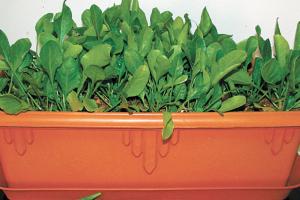August is a good month for growing vegetables in pots
Imagine a law that outlawed traditional Christmas celebrations, and required that henceforth Christmas would not be a joyous occasion but a solemn one.
Parliament did just that in the 1600s and gave birth to the English ballad, “The World Turned Upside Down.”
And the garden world can be turned upside down a bit too. Instead of planting in spring, it’s August and time to plant. Think spring but in reverse; as the weeks go by, it will get cooler, not warmer.
Because an August garden is facing a literal deadline in a few months, try to focus on crops or vegetables that are quick to mature, such as leafy greens that can be eaten at any age.
August is a good month for growing vegetables in pots. Use large containers with good drainage.
An advantage of container growing is that you can move the pots in and out of direct sunlight as needed, giving them sunnier spots as the days get shorter.
Some good crops to sow in August include both forms of arugula, the spicier wild arugula (Diplotaxisx), and the mellower cultivated arugula (Eruca vesicaria ). Also sow seeds for beets (Beta vulgaris), carrots (Daucus carota var. sativus), peas (Pisum sativum), collard greens (Brassica oleracea), kale (Brassica oleracea acephala), and lettuce (Lactuca sativa).
If your local nursery has transplants, try putting in broccoli, Brussels sprouts, cabbage, leeks, and maybe a mature tomato or two.
To replace nutrients used up by the first crop, you may want to fertilize and build up the soil for round two.
Organic fertilizers have many advantages. Organic just means the fertilizer is made or derived from living organisms.
An easy-to-use organic fertilizer is plain compost.
Compost not only helps soil hold moisture better, it adds key nutrients and beneficial microorganisms to your soil.
Commercial compost is available, or you can make your own compost from yard trimmings, grass clippings and kitchen vegetable scraps. Dig in large amounts of compost right after you have pulled out the previous crop.
Once your crops are up and growing, you can use water-based fertilizers such as fish emulsion or seaweed emulsion. These add nitrogen which is good for leafy green plants such as lettuce, kale and beets.
Fish emulsion is good for just about every plant, even flowers. Like all liquid fertilizer, diluted fish emulsion drains quickly into the soil where it is quickly broken down by microorganisms into food for plants. This rapid but safe burst of nutrients is ideal to help plants overcome transplant shock.
In addition to adding compost to your soil, try watering with compost tea. This is made just like a cup of tea in the kitchen but using compost instead of a tea bag. Add several cups of compost to a bucket of water and let it sit, or steep, for a day or two. The water should be brown. If you are using a watering can or spray fertilizer applicator, strain the compost tea first.
You can also use composted manure. That is manure that is older than nine months. Only use manure from cows, horses, rabbits and poultry such as chickens.
Never use manure from household pets or humans, as it can carry disease. Because raw animal manures are often mixed with feed such as hay, or bedding such as straw, these need time to break down as well.
Take advantage of August weather to plant a fall crop of greens, carrots and peas. They’ll be ready in time for a fall picnic in a world turned upside down.




















































